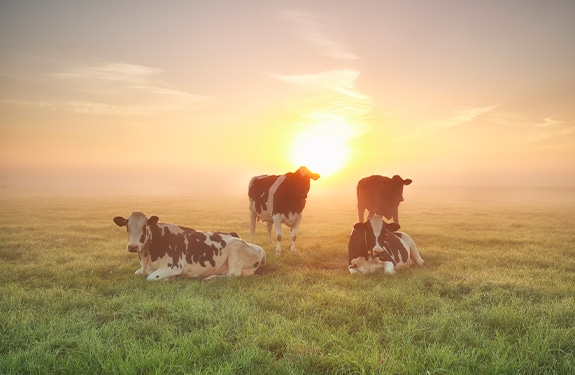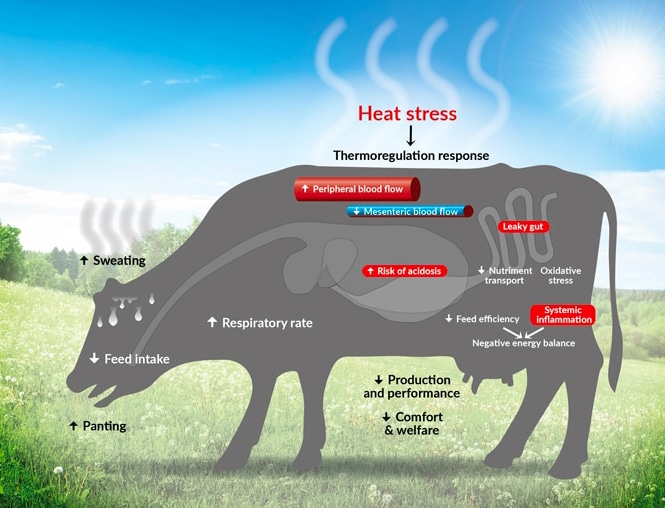07 May Predict and act: Heat stress management made better
Mohamed Mammari, PhD, Global Program Manager, Phileo by Lesaffre.
 Heat stress will cost the global dairy sector an estimated $5 billion a year in 2050 (Wankar et al., 2021).To reduce the costs for both the farmer and animal, a more integrated approach regarding production, health and welfare is needed. The key lies in prediction tools in combination with target nutritional solutions.
Heat stress will cost the global dairy sector an estimated $5 billion a year in 2050 (Wankar et al., 2021).To reduce the costs for both the farmer and animal, a more integrated approach regarding production, health and welfare is needed. The key lies in prediction tools in combination with target nutritional solutions.
Heat stress management in farm animals is on the industry’s radar for many years, but is more topical than ever for multiple reasons. With the increased global demand for dairy production, we see an increase in the number of dairy cows in hot and new dairy regions like the Middle East and Asia. At the same time, we thrive to make these systems in these challenging conditions as efficient as possible with high milk outputs and high feed efficiency.
We can all bring up the image of a very hot subtropical desert, where the temperature sometimes exceeds 40°C (104°F). In the meantime, it is getting hotter in other parts of the world as well, due to global warming. According to data from NOAA (National Centers for Environmental Information, 2020), the earth’s temperature has risen by 0.08°C (0.14°F) per decade since 1880, and the rate of warming over the past 40 years is more than twice that: 0.18°C (0.32°F) per decade since 1981. In farming, climate changes could increase thermal stress for animals and thereby reduce their production and profitability by lowering feed efficiency, growth rates, reproduction rates and welfare. Heat stress might be an old problem, but it requires new effective and integrated solutions to deal with this better and more sustainably in the future.
Cows like it cool
Heat stress is defined as an increase in core body temperature above its normal range. This is especially the case for high producing cows that generate more heat because of the higher feed intake and related raised metabolic heat increment. The comfort zone or thermoneutral zone for a dairy cow is wide varying from around -15°C to +25°C. Dairy cows are therefore mostly farmed in mild and somewhat colder ambient temperatures that are ideal for both grass production and the animal’s preferences. But also humidity (in %) plays a role. In livestock we therefore speak about a Temperature Humidity Index (THI), a combination of temperature and humidity, as a threshold for heat stress.
When the THI unit is over 68 (22°C, 50% Humidity), dairy cows start to show moderate heat stress related symptoms. When it goes over 80 and 90, we speak about high and severe heat stress respectively, with more dramatic effects on performance, animal health and animal welfare (Figure 1). In a 2-year study conducted under field conditions, Bernabucci et al. (2010) found a decrease of 0.27 kg of milk per THI unit when Holstein cows were exposed to a THI higher than 68. The effects of heat stress can be seen on cow level (changes in behaviour), on blood and hormone level, at metabolic level and at cell level.
An integrated management approach
The management strategies available to combat heat stress are focused on 1) maintain body temperature and comfort, 2) increase production and performance and 3) enhance welfare and wellbeing. Practical and common ways to maintain body temperature is to provide shade, ventilation, cooling and enough fresh and cool drinking water. Production and performance is often focused on maintaining feed intake and preventing drop in milk production and milk fat depression. This can be done by timing of feeding and spreading the meals over the day. Heat stress is also directly linked with animal welfare and wellbeing. An increased respiratory rate, body temperature, and cortisol concentration in the blood impacts cow wellbeing and should therefore always be controlled when THI units increase.
Phileo has developed a unique Program Heat stress, based on probiotic and postbiotic nutritional solutions. The use of yeast-based solutions is an important part of this integrated approach. Trials confirmed that the yeast probiotic Actisaf® Sc 47, the yeast postbiotic Safmannan®, and the organic selenium enriched yeast Selsaf®, can counteract some of the negative effects on production and animal welfare during heat stress. Trials confirmed that the yeast-based solutions reduce respiratory rate, body temperature and cortisol (stress hormone), which are all important parameters for animal welfare (Figure 2).
The yeast probiotic Actisaf® Sc 47 maintains zootechnical performance during moderate to high heat stress (77>THI>83). Trials showed an increased milk production (+1.5kg/day) and dry matter intake (+600g/day) in heat-stressed dairy cows (Moallem et al., 2009).
Adding yeast-based solutions to the diet of heat-stressed cows also changes some important blood parameters, like glucose which has a direct impact on cows’ physiology and metabolism. Improved metabolism and heat stress adaptation of dairy cows leads to better comfort (higher DMI, lower respiratory rate) and higher production (milk quantity and quality), which in turn leads to increased health, welfare and productivity.
Early warning system
A nutritional approach should be implemented at the right time. The THI is the most reliable and useful indicator of heat stress and can be used as a forecast system to assess the possible threat or danger to the animals due to climatic variations. Phileo’s Program Heat stress also integrates a mobile app to calculate the THI and hence estimate the impact of heat stress on milk production and possible losses for the farmer and the effect of nutritional strategies. By using predictive and management tools like this, a farmer can measure heat stress responses, know when the animal is in need of attention, and take action. Heat stress will not go away, but science has brought us better and more integrated solutions to deal with this challenge now and in the future. Phileo is offering an integrated science based approach, focusing on performance, profitability, animal welfare and sustainability.
Benefits of using yeast-based solutions in heat-stressed cows:
- Improves rumen health, feed intake and FCR (feed conversion ratio)
- Reduces inflammation
- Restores positive energy balance
- Lowers respiratory rate, temperature and cortisol
- Increases milk production and milk solids
Program Heat stress leads to great gains:
- Better animal welfare and health
- Improved livestock production and performance
For profitable and sustainable dairy sector
References
- Wankar, A., Rindhe, S., Doijad, N., 2021. Heat stress in dairy animals and current milk production trends, economics, and future perspectives: the global scenario. Tropical Animal Health and Production 53. https://doi.org/10.1007/s11250-020-02541-x
- National Centers for Environmental Information (NOAA, 2020). Global Climate Report – Annual 2020. https://www.ncdc.noaa.gov/sotc/global/202013
- Bernabucci et al., 2010 Metabolic & hormonal acclimation to heat stress in domesticated ruminants. The Animal Consortium.
- Moallem et al., 2009. The effects of live yeast supplementation to dairy cows during the hot season on production, feed efficiency, and digestibility. J. Dairy 92:343–351









Sorry, the comment form is closed at this time.